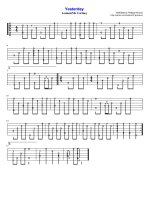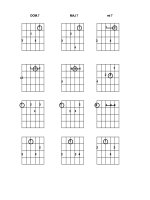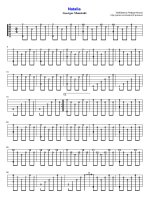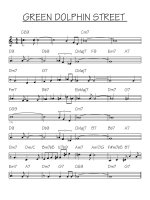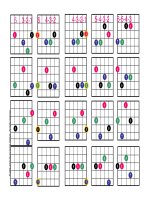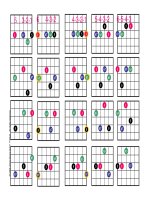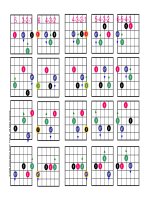PHP 7 quick scripting reference, second edition tủ tài liệu bách khoa
Bạn đang xem bản rút gọn của tài liệu. Xem và tải ngay bản đầy đủ của tài liệu tại đây (15.41 MB, 138 trang )
T HE E X P ER T ’S VOIC E ® IN W E B D E V E L O P M E N T
PHP 7
Quick Scripting
Reference
Second Edition
—
Mikael Olsson
www.allitebooks.com
PHP 7 Quick
Scripting Reference
Second Edition
Mikael Olsson
www.allitebooks.com
PHP 7 Quick Scripting Reference
Mikael Olsson
Hammarland,
Finland
ISBN-13 (pbk): 978-1-4842-1921-8
DOI 10.1007/978-1-4842-1922-5
ISBN-13 (electronic): 978-1-4842-1922-5
Library of Congress Control Number: 2016941199
Copyright © 2016 by Mikael Olsson
This work is subject to copyright. All rights are reserved by the Publisher, whether the whole or part
of the material is concerned, specifically the rights of translation, reprinting, reuse of illustrations,
recitation, broadcasting, reproduction on microfilms or in any other physical way, and transmission
or information storage and retrieval, electronic adaptation, computer software, or by similar or
dissimilar methodology now known or hereafter developed. Exempted from this legal reservation are
brief excerpts in connection with reviews or scholarly analysis or material supplied specifically for
the purpose of being entered and executed on a computer system, for exclusive use by the purchaser
of the work. Duplication of this publication or parts thereof is permitted only under the provisions
of the Copyright Law of the Publisher’s location, in its current version, and permission for use must
always be obtained from Springer. Permissions for use may be obtained through RightsLink at the
Copyright Clearance Center. Violations are liable to prosecution under the respective Copyright Law.
Trademarked names, logos, and images may appear in this book. Rather than use a trademark
symbol with every occurrence of a trademarked name, logo, or image we use the names, logos, and
images only in an editorial fashion and to the benefit of the trademark owner, with no intention of
infringement of the trademark.
The use in this publication of trade names, trademarks, service marks, and similar terms, even if they
are not identified as such, is not to be taken as an expression of opinion as to whether or not they are
subject to proprietary rights.
While the advice and information in this book are believed to be true and accurate at the date of
publication, neither the authors nor the editors nor the publisher can accept any legal responsibility
for any errors or omissions that may be made. The publisher makes no warranty, express or implied,
with respect to the material contained herein.
Managing Director: Welmoed Spahr
Lead Editor: Steve Anglin
Technical Reviewer: Jamie Rumbelow
Editorial Board: Steve Anglin, Pramila Balan, Louise Corrigan, Jonathan Gennick,
Robert Hutchinson, Celestin Suresh John, Michelle Lowman, James Markham,
Susan McDermott, Matthew Moodie, Jeffrey Pepper, Douglas Pundick,
Ben Renow-Clarke, Gwenan Spearing
Coordinating Editor: Mark Powers
Copy Editor: Kim Burton-Weisman
Compositor: SPi Global
Indexer: SPi Global
Artist: SPi Global
Distributed to the book trade worldwide by Springer Science+Business Media New York,
233 Spring Street, 6th Floor, New York, NY 10013. Phone 1-800-SPRINGER, fax (201) 348-4505,
e-mail , or visit www.springeronline.com. Apress Media, LLC is a
California LLC and the sole member (owner) is Springer Science + Business Media Finance Inc
(SSBM Finance Inc). SSBM Finance Inc is a Delaware corporation.
For information on translations, please e-mail , or visit www.apress.com.
Apress and friends of ED books may be purchased in bulk for academic, corporate, or promotional
use. eBook versions and licenses are also available for most titles. For more information, reference
our Special Bulk Sales–eBook Licensing web page at www.apress.com/bulk-sales.
Any source code or other supplementary materials referenced by the author in this text is available
to readers at www.apress.com/9781484219218. For detailed information about how to locate your
book’s source code, go to www.apress.com/source-code/. Readers can also access source code at
SpringerLink in the Supplementary Material section for each chapter.
Printed on acid-free paper
www.allitebooks.com
Contents at a Glance
About the Author ..............................................................................xv
About the Technical Reviewer ........................................................xvii
Introduction .....................................................................................xix
■ Chapter 1: Using PHP...................................................................... 1
■Chapter 2: Variables ....................................................................... 5
■Chapter 3: Operators ...................................................................... 9
■Chapter 4: String .......................................................................... 15
■Chapter 5: Arrays ......................................................................... 19
■Chapter 6: Conditionals ................................................................ 23
■Chapter 7: Loops........................................................................... 27
■Chapter 8: Functions .................................................................... 31
■Chapter 9: Class ........................................................................... 39
■Chapter 10: Inheritance ................................................................ 45
■Chapter 11: Access Levels............................................................ 49
■Chapter 12: Static ......................................................................... 53
■Chapter 13: Constants .................................................................. 57
■Chapter 14: Interface .................................................................... 61
■Chapter 15: Abstract .................................................................... 65
■Chapter 16: Traits ......................................................................... 69
iii
www.allitebooks.com
■ CONTENTS AT A GLANCE
■Chapter 17: Importing Files .......................................................... 71
■Chapter 18: Type Declarations ...................................................... 75
■Chapter 19: Type Conversions ...................................................... 79
■Chapter 20: Variable Testing......................................................... 81
■Chapter 21: Overloading ............................................................... 87
■Chapter 22: Magic Methods ......................................................... 91
■Chapter 23: User Input.................................................................. 97
■Chapter 24: Cookies ................................................................... 103
■Chapter 25: Sessions .................................................................. 105
■Chapter 26: Namespaces ............................................................ 107
■Chapter 27: References .............................................................. 113
■Chapter 28: Advanced Variables ................................................ 117
■Chapter 29: Error Handling ......................................................... 121
■Chapter 30: Exception Handling ................................................. 127
■Chapter 31: Assertions ............................................................... 131
Index .............................................................................................. 133
iv
www.allitebooks.com
Contents
About the Author ............................................................................. xv
About the Technical Reviewer ....................................................... xvii
Introduction .................................................................................... xix
■Chapter 1: Using PHP...................................................................... 1
Embedding PHP ....................................................................................... 1
Outputting Text ........................................................................................ 2
Installing a Web Server ........................................................................... 3
Hello World .............................................................................................. 3
Compile and Parse .................................................................................. 4
Comments ............................................................................................... 4
■Chapter 2: Variables ....................................................................... 5
Defining Variables ................................................................................... 5
Data Types ............................................................................................... 5
Integer Type ............................................................................................. 6
Floating-Point Type .................................................................................. 7
Bool Type ................................................................................................. 7
Null Type .................................................................................................. 7
Default Values ......................................................................................... 7
v
www.allitebooks.com
■ CONTENTS
■Chapter 3: Operators ...................................................................... 9
Arithmetic Operators ............................................................................... 9
Assignment Operators ............................................................................. 9
Combined Assignment Operators .......................................................... 10
Increment and Decrement Operators .................................................... 10
Comparison Operators........................................................................... 11
Logical Operators .................................................................................. 11
Bitwise Operators .................................................................................. 12
Operator Precedence............................................................................. 12
Additional Logical Operators ................................................................. 13
■Chapter 4: String .......................................................................... 15
String Concatenation ............................................................................. 15
Delimiting Strings .................................................................................. 15
Heredoc Strings..................................................................................... 16
Nowdoc Strings .................................................................................... 16
Escape Characters ................................................................................ 16
Character Reference ............................................................................. 17
String Compare ..................................................................................... 17
■Chapter 5: Arrays ......................................................................... 19
Numeric Arrays...................................................................................... 19
Associative Arrays ................................................................................. 20
Mixed Arrays.......................................................................................... 20
Multi-Dimensional Arrays ...................................................................... 21
vi
www.allitebooks.com
■ CONTENTS
■Chapter 6: Conditionals ................................................................ 23
If Statement........................................................................................... 23
Switch Statement .................................................................................. 24
Alternative Syntax ................................................................................. 24
Mixed Modes ......................................................................................... 25
Ternary Operator ................................................................................... 25
■Chapter 7: Loops........................................................................... 27
While Loop............................................................................................. 27
Do-while Loop ....................................................................................... 27
For Loop ................................................................................................ 27
Foreach Loop ......................................................................................... 28
Alternative Syntax ................................................................................. 29
Break ..................................................................................................... 29
Continue ............................................................................................... 29
Goto ....................................................................................................... 30
■Chapter 8: Functions .................................................................... 31
Defining Functions ................................................................................ 31
Calling Functions ................................................................................... 31
Function Parameters ............................................................................. 32
Default Parameters ............................................................................... 32
Variable Parameter Lists ....................................................................... 33
Return Statement .................................................................................. 34
Scope and Lifetime ............................................................................... 34
Anonymous Functions ........................................................................... 36
vii
www.allitebooks.com
■ CONTENTS
Closures ................................................................................................ 37
Generators ............................................................................................. 37
Built-in Functions .................................................................................. 38
■Chapter 9: Class ........................................................................... 39
Instantiating an Object .......................................................................... 40
Accessing Object Members ................................................................... 40
Initial Property Values............................................................................ 40
Constructor............................................................................................ 41
Destructor ............................................................................................. 42
Case Sensitivity ..................................................................................... 42
Object Comparison ................................................................................ 42
Anonymous Classes .............................................................................. 43
Closure Object ....................................................................................... 43
■Chapter 10: Inheritance ................................................................ 45
Overriding Members .............................................................................. 46
Final Keyword ....................................................................................... 47
Instanceof Operator ............................................................................... 47
■Chapter 11: Access Levels............................................................ 49
Private Access ....................................................................................... 49
Protected Access ................................................................................... 50
Public Access ....................................................................................... 50
Var Keyword ......................................................................................... 50
Object Access ........................................................................................ 50
Access Level Guideline.......................................................................... 51
viii
www.allitebooks.com
■ CONTENTS
■Chapter 12: Static ......................................................................... 53
Referencing Static Members ................................................................. 53
Static Variables...................................................................................... 54
Late Static Bindings .............................................................................. 55
■Chapter 13: Constants .................................................................. 57
Const ..................................................................................................... 57
Define .................................................................................................... 58
Const and define ................................................................................... 58
Constant Guideline ................................................................................ 59
Magic Constants.................................................................................... 59
■Chapter 14: Interface .................................................................... 61
Interface Signatures .............................................................................. 61
Interface Example ................................................................................. 62
Interface Usages ................................................................................... 63
Interface Guideline ................................................................................ 63
■Chapter 15: Abstract .................................................................... 65
Abstract Methods .................................................................................. 65
Abstract Example .................................................................................. 65
Abstract Classes and Interfaces ............................................................ 66
Abstract Guideline ................................................................................. 67
■Chapter 16: Traits ......................................................................... 69
Inheritance and Traits ............................................................................ 70
Trait Guidelines...................................................................................... 70
ix
www.allitebooks.com
■ CONTENTS
■Chapter 17: Importing Files .......................................................... 71
Include Path .......................................................................................... 71
Require .................................................................................................. 72
Include_once ......................................................................................... 72
Require_once ........................................................................................ 72
Return.................................................................................................... 73
_Autoload .............................................................................................. 73
■Chapter 18: Type Declarations ...................................................... 75
Argument Type Declarations ................................................................. 75
Return Type Declarations ...................................................................... 77
Strict Typing .......................................................................................... 77
■Chapter 19: Type Conversions ...................................................... 79
Explicit Casts ......................................................................................... 79
Set type .................................................................................................. 80
Get type .................................................................................................. 80
■Chapter 20: Variable Testing......................................................... 81
Isset ....................................................................................................... 81
Empty .................................................................................................... 81
Is_null.................................................................................................... 82
Unset ..................................................................................................... 82
Null Coalescing Operator ....................................................................... 83
Determining Types................................................................................. 83
Variable Information .............................................................................. 84
x
■ CONTENTS
■Chapter 21: Overloading ............................................................... 87
Property Overloading ............................................................................. 87
Method Overloading .............................................................................. 88
Isset and unset Overloading .................................................................. 88
■Chapter 22: Magic Methods ......................................................... 91
_ToString ............................................................................................... 92
_Invoke .................................................................................................. 93
Object Serialization ............................................................................... 93
_Sleep ................................................................................................... 94
_Wakeup ............................................................................................... 94
Set State................................................................................................ 94
Object Cloning ....................................................................................... 95
■Chapter 23: User Input.................................................................. 97
HTML Form ............................................................................................ 97
Sending with POST ................................................................................ 97
Sending with GET .................................................................................. 98
Request Array ........................................................................................ 98
Security Concerns ................................................................................. 98
Submitting Arrays .................................................................................. 99
File Uploading...................................................................................... 100
Superglobals ....................................................................................... 101
■Chapter 24: Cookies ................................................................... 103
Creating Cookies ................................................................................. 103
Cookie Array ........................................................................................ 103
Deleting Cookies ................................................................................. 103
xi
■ CONTENTS
■Chapter 25: Sessions .................................................................. 105
Starting a Session ............................................................................... 105
Session Array ...................................................................................... 105
Deleting a Session............................................................................... 106
■Chapter 26: Namespaces ............................................................ 107
Creating Namespaces ......................................................................... 107
Nested Namespaces ........................................................................... 108
Alternative Syntax ............................................................................... 108
Referencing Namespaces ................................................................... 109
Namespace Aliases ............................................................................. 110
Namespace Keyword .......................................................................... 111
Namespace Guideline.......................................................................... 112
■Chapter 27: References .............................................................. 113
Assign by Reference............................................................................ 113
Pass by Reference ............................................................................... 113
Return by Reference............................................................................ 115
■Chapter 28: Advanced Variables ................................................ 117
Curly Syntax ........................................................................................ 117
Variable Variable Names...................................................................... 118
Variable Function Names .................................................................... 118
Variable Class Names .......................................................................... 119
■Chapter 29: Error Handling ......................................................... 121
Correcting Errors ................................................................................. 121
Error Levels ......................................................................................... 122
Error-Handling Environment ................................................................ 123
xii
■ CONTENTS
Custom Error Handlers ........................................................................ 124
Raising Errors ...................................................................................... 125
■Chapter 30: Exception Handling ................................................. 127
Try-catch Statement ............................................................................ 127
Throwing Exceptions ........................................................................... 127
Catch Block ......................................................................................... 128
Finally Block ........................................................................................ 128
Rethrowing Exceptions........................................................................ 129
Uncaught Exception Handler ............................................................... 129
Errors and Exceptions ......................................................................... 129
■Chapter 31: Assertions ............................................................... 131
Assert Performance............................................................................. 131
Index .............................................................................................. 133
xiii
About the Author
Mikael Olsson is a professional web entrepreneur,
programmer, and author. He works for an R&D
company in Finland, where he specializes in software
development.
In his spare time, Mikael writes books and creates
web sites on his various fields of interest. The books
that he writes are focused on efficiently teaching
the subject by explaining only what is relevant and
practical, without any unnecessary repetition or theory.
xv
About the Technical
Reviewer
Jamie Rumbelow is a freelance web developer and an aspiring academic. He’s the author
of three books on CodeIgniter and is a keen public speaker. He has worked on dozens of
web applications during his eight years freelancing. Jamie lives in London, England.
xvii
Introduction
PHP is a server-side programming language used for creating dynamic web sites and
interactive web applications. The acronym PHP originally stood for Personal Home Page,
but as its functionality grew, this was changed to PHP: Hypertext Preprocessor. This
recursive acronym comes from the fact that it takes PHP code as input and produces
HTML as output. This means that users do not need to install any software to view
PHP-generated web pages. All that is required is that the web server has PHP installed to
interpret the script.
In contrast with HTML sites, PHP sites are dynamically generated. Instead of the site
being made up of a large number of static HTML files, a PHP site may consist of only a
handful of template files. The template files describe only the structure of the site using
PHP code, while the web content is pulled from a database and the style formatting
is from Cascading Style Sheets (CSS). This allows for site-wide changes from a single
location, providing a flexible web site that is easy to design, maintain, and update.
When creating web sites with PHP, a content management system (CMS) is generally
used. A CMS provides a fully integrated platform for web site development consisting
of a back end and a front end. The front end is what visitors see when they arrive at the
site, whereas the back end is where the site is configured, updated, and managed by an
administrator. The back end also allows a web developer to change template files and
modify plugins to more extensively customize the functionality and structure of the site.
Examples of free PHP-based CMS solutions include WordPress, Joomla, ModX, and
Drupal, with WordPress being the most popular and accounting for more than half of the
CMS market.
The first version of PHP was created by Rasmus Lerdorf and released in 1995. Since
then, PHP has evolved greatly from a simple scripting language to a fully featured web
programming language. The official implementation is now released by The PHP Group,
with PHP 7 being the most recent version as of this writing. The language may be used
free of charge and is open source, allowing developers to extend it for their own use or to
contribute to its development.
PHP is by far the most popular server-side programming language in use today.
It holds a growing 80% market share when compared with other server-side technologies,
such as ASP.NET, Java, Ruby, and Perl. One of the reasons for the widespread adoption
of PHP is its platform independence. It can be installed on all major web servers and
operating systems, and used with any major database system. Another strong feature
of PHP is its simple-to-use syntax based on C and Perl, which is easy for a newcomer to
learn; however, PHP also offers many advanced features for the professional programmer.
xix
CHAPTER 1
Using PHP
To start developing in PHP, create a plain text file with a .php file extension and open it
in the editor of your choice—for example Notepad, jEdit, Dreamweaver, NetBeans, or
PHPEclipse. This PHP file can include any HTML, as well as PHP scripting code. Begin by
first entering the following minimal markup for an HTML 5 web document.
<!doctype html>
<html>
<head>
<meta charset="UTF-8">
<title>PHP Test</title>
</head>
<body></body>
</html>
Embedding PHP
PHP code can be embedded anywhere in a web document in several different ways.
The standard notation is to delimit the code by <?php and ?>. This is called a PHP code
block, or just a PHP block.
<?php ... ?>
Within a PHP block, the engine is said to be in PHP mode; outside of the block, the
engine is in HTML mode. In PHP mode, everything is parsed (executed) by the PHP
engine; whereas in HTML mode, everything is sent to the generated web page without
any execution.
Electronic supplementary material The online version of this chapter
(doi:10.1007/978-1-4842-1922-5_1) contains supplementary material, which is
available to authorized users.
© Mikael Olsson 2016
M. Olsson, PHP 7 Quick Scripting Reference, DOI 10.1007/978-1-4842-1922-5_1
1
CHAPTER 1 ■ USING PHP
The second notation for switching to PHP mode is a short version of the first where
the php part is left out. Although this notation is shorter, the longer one is preferable if
the PHP code needs to be portable. This is because support for the short delimiter can be
disabled in the php.ini configuration file.1
<? ... ?>
A third (now obsolete) alternative was to embed the PHP code within an HTML
script element with the language attribute set to php. This alternative delimiter was
seldom used; support for it was removed in PHP 7.
<script language="php">...</script>
Another obsolete notation that you may encounter in legacy code is when the script
is embedded between ASP tags. This notation is disabled by default, but it can be enabled
from the PHP configuration file. Use of this notation has long been discouraged. The
ability to enable it was finally removed in PHP 7.
<% ... %>
The last closing tag in a script file may be omitted to make the file end while it is still
in PHP mode.
<?php ... ?>
Outputting Text
Printing text in PHP is done by either typing echo or print followed by the output. Each
statement must end with a semicolon (;) in order to separate it from other statements.
The semicolon for the last statement in a PHP block is optional, but it is a good practice to
include it.
echo "Hello World";
print "Hello World";
?>
Output can also be generated using the is valid even if the short PHP delimiter is disabled.
<?= "Hello World" ?>
1
/>
2
CHAPTER 1 ■ USING PHP
Keep in mind that text displayed on a web page should always be located within the
HTML body element.
<body>
<?php echo "Hello World"; ?>
</body>
Installing a Web Server
To view PHP code in a browser, the code first has to be parsed on a web server with the
PHP module installed. An easy way to set up a PHP environment is to download and
install a distribution of the popular Apache web server called XAMPP,2 which comes
preinstalled with PHP, Perl, and MySQL. It allows you to experiment with PHP on your
own computer.
After installing the web server, point your browser to http://localhost to make sure
that the server is online. It should display the index.php file, which by default is located
under C:\xampp\htdocs\index.php on a Windows machine. htdocs is the folder that the
Apache web server looks to for files to serve on your domain.
Hello World
Continuing from before, the simple Hello World PHP web document should look like this:
<!doctype html>
<html>
<head>
<meta charset="UTF-8">
<title>PHP Test</title>
</head>
<body>
<?php echo "Hello World"; ?>
</body>
</html>
To view this PHP file parsed into HTML, save it to the web server’s htdocs folder (the
server’s root directory) with a name such as mypage.php. Then point your browser to its
path, which is http://localhost/mypage.php for a local web server.
When a request is made for the PHP web page, the script is parsed on the server and
sent to the browser as only HTML. If the source code for the web site is viewed, it will not
show any of the server-side code that generated the page—only the HTML output.
2
/>
3
CHAPTER 1 ■ USING PHP
Compile and Parse
PHP is an interpreted language, not a compiled language. Every time a visitor arrives at
a PHP web site, the PHP engine compiles the code and parses it into HTML, which is
then sent to the visitor. The main advantage of this is that the code can be changed easily
without having to recompile and redeploy the web site. The main disadvantage is that
compiling the code at run-time requires more server resources.
For a small web site, a lack of server resources is seldom an issue. The time it takes
to compile the PHP script is also miniscule compared to other factors, such as the time
required to execute database queries. However, for a large web application with lots
of traffic, the server load from compiling PHP files is likely to be significant. For such a
site, the script compilation overhead can be removed by precompiling the PHP code.
This can be done with eAccelerator,3 for example, which caches PHP scripts in their
compiled state.
A web site that only serves static content (the same to all visitors) has another
possibility, which is to cache the fully generated HTML pages. This provides all the
maintenance benefits of having a dynamic site, with the speed of a static site. One such
caching tool is the W3 Total Cache4 plugin for the WordPress CMS.
Comments
Comments are used to insert notes into the code. They have no effect on the parsing of
the script. PHP has the two standard C++ notations for single-line (//) and multiline
(/* */) comments. The Perl comment notation (#) may also be used to make single-line
comments.
// single-line comment
# single-line comment
/* multi-line
comment */
?>
As in HTML, whitespace characters—such as spaces, tabs, and comments—are
ignored by the PHP engine. This allows you a lot of freedom in how to format your code.
3
4
/>
4
CHAPTER 2
Variables
Variables are used for storing data, such as numbers or strings, so that they can be used
multiple times in a script.
Defining Variables
A variable starts with a dollar sign ($) followed by an identifier, which is the name of
the variable. A common naming convention for variables is to have each word initially
capitalized, except for the first one.
$myVar;
A value can be assigned to a variable by using the equals sign, or assignment
operator (=). The variable then becomes defined or initialized.
$myVar = 10;
Once a variable has been defined, it can be used by referencing the variable’s name.
For example, the value of the variable can be printed to the web page by using echo
followed by the variable’s name.
echo $myVar; // "10"
Keep in mind that variable names are case sensitive. Names in PHP can include
underscore characters and numbers, but they cannot start with a number. They also
cannot contain spaces or special characters, and they must not be a reserved keyword.
Data Types
PHP is a loosely typed language. This means that the type of data that a variable can store
is not specified. Instead, a variable’s data type changes automatically to hold the value
that it is assigned.
$myVar = 1;
// int type
$myVar = 1.5; // float type
© Mikael Olsson 2016
M. Olsson, PHP 7 Quick Scripting Reference, DOI 10.1007/978-1-4842-1922-5_2
5


